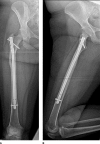Femoral Derotation Osteotomy in Adults for Version Abnormalities
- PMID: 30106763
- PMCID: PMC6147096
- DOI: 10.5435/JAAOS-D-17-00623
Femoral Derotation Osteotomy in Adults for Version Abnormalities
Abstract
Background: Version abnormalities of the femur can cause pain and hip joint damage due to impingement or instability. A retrospective clinical review was conducted on patients undergoing a subtrochanteric derotation osteotomy for either excessive anteversion or retroversion of the femur.
Methods: A total of 55 derotation osteotomies were performed in 43 patients: 36 females and 7 males. The average age was 29 years (range, 14 to 59 years). The osteotomies were performed closed with an intramedullary saw. Fixation was performed with a variety of intramedullary nails. Twenty-nine percent of patients had a retroversion deformity (average, -9° of retroversion; range, +2° to -23°) and 71% had excessive anteversion of the femur (average, +37° of anteversion; range, +22° to +53°). The etiology was posttraumatic in 5 patients (12%), diplegic cerebral palsy in 2 patients (5%), Prader-Willi syndrome in 1 patient (2%), and idiopathic in 35 patients (81%). Forty-nine percent underwent concomitant surgery with the index femoral derotation osteotomy, including hip arthroscopy in 40%, tibial derotation osteotomy in 13%, and a periacetabular osteotomy in 5%. Tibial osteotomies were performed to correct a compensatory excessive external tibial torsion that would be exacerbated in the correction of excessive femoral anteversion.
Results: No patient was lost to follow-up. Failures occurred in three hips in three patients (5%): two hip arthroplasties and one nonunion that healed after rerodding. There was one late infection treated successfully with implant removal and antibiotics with an excellent final clinical outcome. At an average follow-up of 6.5 years (range, 2 to 19.7 years), the modified Harris Hip Score improved by 29 points in the remaining 52 cases (P < 0.001, Wilcoxon signed-rank test). The results were rated as excellent in 75%, good in 23%, and fair in 2%. Subsequent surgery was required in 78% of hips, 91% of which were implant removals.
Conclusions: A closed, subtrochanteric derotation osteotomy of the femur is a safe and effective procedure to treat either femoral retroversion or excessive anteversion. Excellent or good results were obtained in 93%, despite the need for subsequent implant removal in more than two-thirds of the patients.
Figures




References
-
- Fabricant PD, Fields KG, Taylor SA, Magennis E, Bedi A, Kelly BT: The effect of femoral and acetabular version on clinical outcomes after arthroscopic femoroacetabular impingement surgery. J Bone Joint Surg Am 2015;97:537-543. - PubMed
MeSH terms
Supplementary concepts
LinkOut - more resources
Full Text Sources
Other Literature Sources

